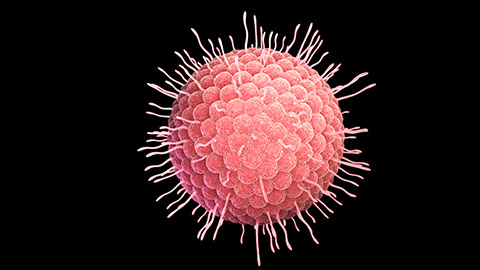
In this episode we do a deep dive into varicella zoster virus and the many confusions about chickenpox, shingles, and a weird invisible form of shingles. Is shingles contagious? Can you get it more than once? Where does the chickenpox vaccine fit? It can be very confusing! Tune in for some useful clarifications.
Resources:
Anderson, Wayne E. “Varicella-Zoster Virus (VZV).” Last modified February 15, 2019. https://emedicine.medscape.com/article/231927-overview.
Centers for Disease Control and Prevention. “Shingles (Herpes Zoster): Transmission.” Last modified July 1, 2019. www.cdc.gov/shingles/about/transmission.html.
Hecht, Marjorie. “Can I Have Shingles Without a Rash?” Last modified November 6, 2018. www.healthline.com/health/shingles-without-rash.
Ratini, Melinda, ed. “Shingles.” November 16, 2019. www.webmd.com/skin-problems-and-treatments/shingles/shingles-skin.


This podcast sponsored by:
About Anatomy Trains:
Anatomy Trains is a global leader in online anatomy education and also provides in-classroom certification programs forstructuralintegration in the US, Canada, Australia, Europe, Japan, and China, as well as fresh-tissue cadaverdissectionlabs and weekend courses. The work of Anatomy Trains originated with founder Tom Myers, who mapped the human body into 13 myofascial meridians in his original book, currently in itsfourthedition and translated into 12 languages. The principles of Anatomy Trains are used by osteopaths,physicaltherapists,bodyworkers,massagetherapists,personaltrainers,yoga,Pilates,Gyrotonics,and other body-minded manual therapists and movement professionals. Anatomy Trains inspires these practitioners to work with holistic anatomy in treating system-wide patterns to provide improved client outcomes in terms of structure and function.
Website:anatomytrains.com
Email:info@anatomytrains.com
Facebook:facebook.com/AnatomyTrains
Instagram: instagram.com/anatomytrainsofficial
0:00:00.0 Speaker 1: Ruth Werner's best-selling book, A Massage Therapist's Guide to Pathology, is a highly regarded comprehensive resource that sets the standard for pathology education. Written for massage therapy students and practitioners, this ground-breaking resource serves up a comprehensive review of the pathophysiology, signs, symptoms and treatment of more than 500 diseases and disorders. Learn more at booksofdiscovery.com.
0:00:32.0 Speaker 2: Anatomy Trains is happy to announce our return to the dissection lab in person, January 10th to the 14th, 2022 at the Laboratory of Anatomical Enlightenment in Boulder, Colorado. We are thrilled to be back in the lab with Anatomy Trains, author Tom Myers and master dissector Todd Garcia join students from around the world and from all types of manual movement and fitness professions to explore the real human form, not the images you get from books. This is an exclusive invitation, email info@anatomytrains.com, if you'd like to join us in the lab.
0:01:09.2 S1: This episode of The ABMP podcast is sponsored by Pain In The App, mobile app by Dr. Ben Benjamin. Pain In The App is a new mobile app to learn about the injury process from head to toe, quiz yourself on the theory behind why injuries happen and what we can do about it, dig into how specific treatments work and why. Get started on Pain In The App with dozens of free questions, then get hundreds more for only 9.99, but be careful, it's addictive. Go to the App Store or Google Play and search for Pain In The App.
[music]
0:01:53.4 Speaker 3: Hi, and welcome to I Have A Client Who pathology conversations with Ruth Werner, the podcast where I will discuss your real life stories about clients with conditions that are perplexing or confusing. I'm Ruth Werner, author of the A Massage Therapist's Guide to Pathology, and I have spent decades studying, writing about and teaching about where massage therapy intersects with diseases and conditions that might limit our client's health. We almost always have something good to offer even with our most challenged clients, but we need to figure out a way to do that safely, effectively and within our scope of practice, and sometimes, as we have all learned that is harder than it looks.
0:02:40.1 S3: Today's episode comes from a post in a Facebook group that led to a surprising number of very vigorous Facebook responses. Some of them contained accurate information, some of them not so much. All of them offered with the best intentions about a topic that can be very confusing, and because there's an infectious element to this common situation, I feel it's important that massage therapists be informed about it. And the story goes like this. I have a client who was diagnosed with shingles around May 13th. She did not have the rash, and she says she feels better. How long do you guys wait until you see post-shingles clients? Thanks in advance. I reached out to this person to ask if I could dedicate in I Have A Client Who episode to this topic and they were amenable, which was very generous.
0:03:34.0 S3: The therapist is located in North Carolina, and here are some details about the client, she's a 49-year-old woman, the therapist and client spoke by phone a couple of weeks before her scheduled appointment, which would be for her first massage ever, and she wanted some help with chronic shoulder and back pain. Then the week before her appointment, she called to tell the therapist that she'd been diagnosed by a doctor with shingles. Her appointment was supposed to happen four days later and she stated that she did not have the rash. The therapist suggested that they wait until all her other symptoms had gone away, and then she would call back to reschedule, and then the therapist came to Facebook to get some guidance on safety parameters for timing.
0:04:17.8 S3: Okay, this to me feels like some lovely low-hanging fruit. I love teaching about shingles and all of its companion problems, so I'm going to give you some information here that is as clear and as accurate as I can provide, and of course, as always, I will give you some resources in our show notes. Here we go. The causative agent at the centre of all this fuss is a virus called Herpes Zoster, or sometimes it's called varicella-zoster, and sometimes the whole thing is shortened to VZV, varicella-zoster virus. Now, the thing about VZV is that it has a pretty predictable pattern in how it behaves, but it breaks the rules all the time.
0:05:11.1 S3: So here's the most typical pattern before the widespread use of the Chickenpox vaccine, which in this country started in the late 1980s. So when a typical pre-vaccine pattern, here's what we would see; At some point in childhood, usually somewhere between infancy and five or six years old, a child would be exposed to VZV and have an episode of Chickenpox, and you might remember Chickenpox involves a body wide outbreak of itchy, itchy blisters on a red base, more severe versions of Chickenpox can involve blisters inside the mouth and into the GI tract, and really, really severe cases can end in hospitalisation with a risk of encephalitis, meningitis and death. We used to lose up to 200 children every year to Chickenpox out of about four million cases each year, but under normal circumstances with a basically healthy child, they would go through Chickenpox, the episode would subside, the blisters would heal and go away, and now this child has antibodies to VZV, and that's terrific because those antibodies seem to last for a really long time, like decades. Unfortunately, this child now also has colonies of virus that take up permanent residence in their target cells, which is to say nerve cells.
0:06:35.3 S3: Colonies of VZV typically hide out in the dorsal root ganglion or the trigeminal ganglion, where if we're really lucky, they go into dormancy and they are never heard from again. For lots and lots of people, this is the last time they will ever have any interaction with Chickenpox until maybe they're around a child or a grandchild who has this infection, but that's it, and we'll talk about why that could be a good thing in a little bit. However, for some people, these colonies of VZV hanging out in the trigeminal nerve or in a dorsal root ganglion, these colonies are primed for the eventual possibility that this child's circulating levels of antibodies might some day decline, and when that happens, the virus is ready and it might reactivate, and the most typical pattern is that this virus reactivates in a different form. It looks like a line or a stripe of blisters that follows a dermatome, and this shows us which nerve it's been hiding in. That line or a stripe might be across the face, around a branch of the trigeminal nerve, or it could go down a leg, or it could wrap around one side of the rib cage, and when that happens, it looks sort of like a belt, and that is the origin of the word shingles.
0:07:57.5 S3: It comes from the Latin cingulum or belt. And the thing about shingles is that it is usually fabulously, incredibly excruciatingly painful. So again, typical pattern, a child contracts Chickenpox, they recover, maybe later in life, they might have a reactivation of that virus that now presents as shingles, and if all goes well, that's the end of that and their interaction with VZV is over forever but as I said a few minutes ago, this virus does not always follow the rules. Some people get Chickenpox more than once, really unlucky people get shingles more than once, and of course, immunosuppressed people are particularly at risk for shingles.
0:08:45.0 S3: When a person with a the history of Chickenpox or the Chickenpox vaccine, which is made of weakened virus, develop shingles, it is almost never the result of a new infection, it is almost always a resurgence of a colony of virus that has been with you since childhood exposure, and this is why we usually see shingles outbreaks among people who are immune compromised or who are mature or who might have had only a minor brush with Chickenpox as a child, so they never had much of a chance to develop a good immune system response to it.
0:09:22.6 S3: Let me take a moment here to talk just a little bit about the Chickenpox vaccine. As I mentioned, this is a vaccine built on a weakened form of the virus, it's extremely safe, and it has basically reduced to zero, the number of children lost to complications of Chickenpox in this country each year. The data says that people who are immune compromised who get the Chickenpox vaccine have a substantially reduced risk of developing shingles, and that's fantastic news. That said there is a low, but not zero chance that someone who's had the Chickenpox vaccine might be at risk for shingles later in life, just because of the way our immune system loses strength over time. One of the places that people sometimes get confused is about whether shingles is contagious, and here's what I can tell you, the blisters are full of virus, and if you had Chickenpox or the Chickenpox vaccine, you are protected, you have antibodies, but an adult who has never been exposed to VZV, we call this being virus naive, could contract the virus and they could go either way and have an initial infection that looks like Chickenpox or an initial infection that looks like shingles.
0:10:47.2 S3: Sometimes people wonder if even though we might have a history of Chickenpox, will our being exposed to Chickenpox or shingles make us have a new infection, and the answer is that our own circulating protections would have to be really low for that to happen. It's possible, but so unlikely. In fact, for someone who's had a history of Chickenpox being exposed to another person who has the virus can act like a booster to our immune system. One of the unexpected consequences of a safe effective Chickenpox vaccine for young children is that their parents and grandparents are not getting the kind of re-exposure to this pathogen that would otherwise prompt their immune system to refresh its strength, and consequently, as fewer and fewer children go through Chickenpox because of the vaccine, more and more seniors are developing shingles because they never have a chance to rebuild their immune system protections, and this is why you sometimes hear about other shingles vaccine, it is essentially a VZV booster for mature people who want to lessen their risk of shingles.
0:12:00.5 S3: Now, let's go back to our client who was described in this question, she said she'd been diagnosed with shingles but she never had a rash. Well, that seems surprising. But here's the deal, shingles doesn't follow the rules. There's a version of shingles called the Zoster Sine Herpete. In this situation, the person has a reactivation of the virus with all the pain sensation, but no visible lesions, sine means without. So this is zoster without herpes lesions. This situation is incredibly painful, but it has no marks on the skin, and so sometimes it is misdiagnosed as something like a herniated disc or a heart attack or some other really painful but otherwise invisible problem. So my guess is that this is what the client is dealing with and the therapist is absolutely correct, it is appropriate to wait until all of her signs and symptoms have passed until doing massage. That's really the main issue about massage in the context of shingles, because here's the deal. If you had Chickenpox in childhood or if you had the Chickenpox vaccine, then you have circulating antibodies that will protect you from other people's infections with VZV.
0:13:21.5 S3: I'll say it one more time. If you're basically healthy and you have a history of Chickenpox or the Chickenpox vaccine, then exposure to shingles is extremely unlikely to cause a new infection. This doesn't mean you can't be a source of its spreading however, remember, those blisters are chock-full of virus and if someone in your workspace who has no history of exposure to VZV, comes in contact with them, then it is possible to share that bounty, but here's some good news, if you wanna call it that. Shingles hurts, it hurts a lot. Conditions that hurt make people cancel massage appointments, and that helps keep us safe from the risk of doing harm, and it helps keep our other VZV naive clients safe from the risk of unintended exposure. The woman described by today's contributor is probably not contagious at all, but simply out of concern for her well-being, it's best to delay her massage until her symptoms have cleared up.
0:14:25.8 S3: Now, I've got one more thing, there's a whole other complication related to shingles that I haven't even touched on yet. Touched on. You see what I did there? I haven't even touched on post-herpetic neuralgia, and that's the situation where the shingles infection subsides, the blisters heal, the virus goes dormant, but the pain continues and continues and continues.
0:14:55.3 S3: I don't have time to go down that pathway today, but I would love to do it in another episode of I Have A Client Who. So do you have a client with post-herpetic neuralgia? Please be sure to let me know and we will make this happen. Hey everybody, thanks for listening to I Have A Client Who pathology conversations with Ruth Werner. Remember, you can send me your I Have A Client Who stories to ihaveaclientwho@abmp.com, that's 'I Have A Client Who', all one word, all lowercase @abmp.com. I can't wait to see what you send me and I'll see you next time.